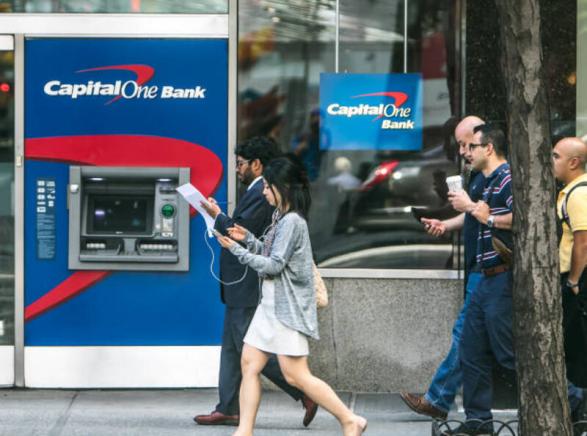The Top 12 Largest Banks in the U.S.: A Comprehensive Guide
Dec 30, 2023 By Triston Martin
In the intricate landscape of American finance, the banking sector distinguishes itself with robust institutions that have stood the test of time. These banks, the largest in the United States, form the backbone of the nation's financial infrastructure, impacting the economic trajectory of the country. Serving millions of customers across the nation and beyond, they provide a variety of services from personal banking to investment advisement. This guide delves into the top 12 largest banks in the U.S., shedding light on their history, operations, and contributions to the American economy. Whether you're an investor, a banking professional, or a curious reader, this comprehensive overview serves to enlighten and inform.
Overview of the U.S. banking industry

Before delving into the specifics of the top 10 largest banks, it's important to have a general understanding of the U.S. banking industry as a whole. The industry can be broadly divided into three sectors: commercial banks, savings institutions, and credit unions.
Commercial banks are financial institutions that are authorized to accept deposits and make loans to individuals and businesses. These include retail banks, investment banks, and industrial banks.
Savings institutions refer to financial institutions that specialize in accepting deposits and providing home mortgages. Examples of savings institutions include savings and loan associations and mutual savings banks.
Credit unions are member-owned financial cooperatives that provide services such as checking accounts, loans, and credit cards. They are not-for-profit organizations that are owned by their members, who are typically affiliated by a shared occupation or community.
The Top 10 Largest Banks in the U.S.
1. JPMorgan Chase & Co.
Founded in 1799, JPMorgan Chase is the largest bank in the U.S. by total assets, with over $3 trillion in assets as of 2021. Headquartered in New York City, the bank has a global presence and offers a wide range of financial services, including consumer and commercial banking, investment banking, and asset management.
2. Bank of America Corporation
With over $2 trillion in assets, Bank of America is the second-largest bank in the U.S. As a diversified financial services company, it offers consumer and commercial banking, wealth management, investment banking, and more. The bank was founded in 1904 and is headquartered in Charlotte, North Carolina.
3. Wells Fargo & Co.
Founded in 1852, Wells Fargo is the third-largest bank in the U.S., with over $1.9 trillion in assets. Based in San Francisco, California, it provides a variety of financial services including consumer and commercial banking, mortgage lending, investment management, and more.
4. Citigroup Inc.
Originally founded in 1812, Citigroup is the fourth-largest bank in the U.S. and has over $1.8 trillion in assets. The global financial services company offers a range of products and services including consumer banking, investment banking, credit cards, and wealth management.
5. U.S. Bancorp
Headquartered in Minneapolis, Minnesota, U.S. Bancorp is the fifth-largest bank in the U.S. with over $500 billion in assets. It offers a range of financial services to individuals, businesses, and institutions, including consumer and business banking, wealth management, and trust services.
6. Truist Financial Corporation
Formed by the merger of BB&T Corporation and SunTrust Banks in 2019, Truist Financial is the sixth-largest bank in the U.S. with over $500 billion in assets. The bank, headquartered in Charlotte, North Carolina, offers a range of financial services including commercial and consumer banking, mortgage lending, and insurance.
7. PNC Financial Services Group Inc.
PNC Financial Services Group is the seventh-largest bank in the U.S. with over $450 billion in assets. Founded in 1845, it is headquartered in Pittsburgh, Pennsylvania and offers consumer and commercial banking, asset management, wealth management, and more.
8. TD Group US Holdings LLC
TD Group US Holdings LLC is the eighth-largest bank in the U.S., with over $400 billion in assets. It is a subsidiary of TD Bank Group, a Canadian multinational banking and financial services company. The bank offers personal and business banking, credit cards, mortgage lending, and more.
9. Capital One Financial Corporation

With over $300 billion in assets, Capital One Financial Corporation is the ninth-largest bank in the U.S. Founded in 1994 and headquartered in McLean, Virginia, the bank offers a range of financial services including credit cards, consumer and commercial banking, and auto loans.
10. The Goldman Sachs Group Inc.
Founded in 1869, The Goldman Sachs Group is the tenth-largest bank in the U.S., with over $300 billion in assets. Headquartered in New York City, it is a global investment banking, securities and investment management firm that offers a range of financial services to corporations, governments, and individuals.
11. Morgan Stanley
Morgan Stanley is a global financial services firm that is headquartered in New York City and has over $250 billion in assets. Founded in 1935, the bank offers wealth management, investment banking, and institutional securities.
12. State Street Corporation
Founded in 1792, State Street Corporation is the twelfth-largest bank in the U.S. with over $200 billion in assets. Headquartered in Boston, Massachusetts, the bank offers a range of financial services including investment management, securities lending, and more.
Conclusion
The U.S. banking industry plays a crucial role in the country's economy, providing individuals and businesses with essential financial services. The top 12 largest banks in the U.S. are major players in this industry, offering a wide range of products and services to meet the needs of their customers. As the industry continues to evolve and adapt to changing economic conditions, it will be interesting to see how these banks continue to grow and innovate in the years to come. So, it is important for consumers to stay informed about the different types of financial institutions and their offerings in order to make informed decisions about their banking needs.







